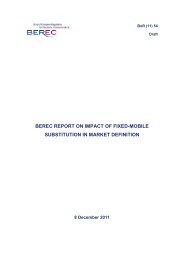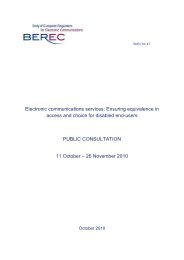Vodafone response to the public consultation by ... - BEREC - Europa
Vodafone response to the public consultation by ... - BEREC - Europa
Vodafone response to the public consultation by ... - BEREC - Europa
You also want an ePaper? Increase the reach of your titles
YUMPU automatically turns print PDFs into web optimized ePapers that Google loves.
Basic broadband – supply side issues<br />
(e.g. telemedicine)<br />
While <strong>the</strong> European average basic broadband coverage is now over 95% of population, <strong>the</strong>re are<br />
discrepancies between countries ranging from 76% in Poland <strong>to</strong> nearly 100% in o<strong>the</strong>r four EU<br />
countries. Areas without coverage are clearly in rural areas. According <strong>to</strong> <strong>the</strong> European Commission,<br />
only 82.5% of <strong>the</strong> rural population is within broadband coverage. The reasons are mainly economic.<br />
The investments needed <strong>to</strong> upgrade <strong>the</strong> local switches and connect <strong>the</strong>m with fibre backhauling are<br />
simply <strong>to</strong>o high compared <strong>to</strong> foreseen returns. In addition, technical issues such as <strong>the</strong> length of <strong>the</strong><br />
copper pair, incompatible with high DSL rate, will not allow some households <strong>to</strong> get broadband<br />
unless significant investments are put in place.<br />
The European Commission and national Governments are fully aware of <strong>the</strong> issue. As highlighted in<br />
<strong>the</strong> <strong>BEREC</strong> report, all EU countries have in place plans <strong>to</strong> subsides roll-out of DSL services in rural<br />
areas. The European Commission has also provided guidance in this area <strong>to</strong> make sure that such<br />
initiatives are compatible with State Aid rules. It is unclear whe<strong>the</strong>r <strong>the</strong>se initiatives will be sufficient<br />
<strong>to</strong> reach <strong>the</strong> Digital Agenda objective of 100% 2 Mbps coverage <strong>by</strong> 2013.<br />
However, not much attention has been dedicated <strong>to</strong> <strong>the</strong> role that mobile could play in this area via<br />
3G and 4G technologies. Mobile broadband has already a key role in complementing current fixed<br />
broadband. It is also, <strong>to</strong> some extent, providing broadband connection <strong>to</strong> categories of cus<strong>to</strong>mers<br />
that do not have access <strong>to</strong> a fixed line because without a permanent address or because do not want<br />
<strong>to</strong> have long term contract obligations (minimum contract duration for fixed broadband range<br />
between 12 and 24 months).<br />
Mobile broadband coverage already reached large parts of <strong>the</strong> population using <strong>the</strong> 3G network<br />
based on 2.1 GHz spectrum and, more recently on <strong>the</strong> 900 MHz spectrum. The launch of LTE services<br />
in Germany last year, <strong>to</strong> be gradually followed <strong>by</strong> <strong>the</strong> rest of Europe, will guarantee fur<strong>the</strong>r<br />
substantial increases in coverage level <strong>by</strong> opera<strong>to</strong>rs and more, importantly, it will provide <strong>the</strong><br />
necessary performance and capacity similar or above current DSL services.<br />
The concept of closing <strong>the</strong> digital divide via mobile broadband technologies has been put in practice<br />
<strong>by</strong> <strong>Vodafone</strong>:<br />
� In Italy with <strong>the</strong> launch of <strong>the</strong> “1000Comuni” initiative in 2010 that aims <strong>to</strong> bring broadband<br />
coverage <strong>to</strong> at least 1000 communities in “digital divide” villages across Italy. In June 2011,<br />
<strong>Vodafone</strong> had already received over 2000 applications and covered almost 200 villages. 1<br />
� In Germany, <strong>Vodafone</strong> started <strong>the</strong> LTE roll out in September 2010 delivering broadband <strong>to</strong><br />
around 1000 rural communities with 165,000 households that did not have access <strong>to</strong> ei<strong>the</strong>r<br />
fixed or broadband before. The objective is <strong>to</strong> practically eliminate <strong>the</strong> digital divide in<br />
Germany. 2<br />
1 See http://1000comuni.vodafone.it/aree_coperte/<br />
2 See http://www.vodafone.de/lte/<br />
3





